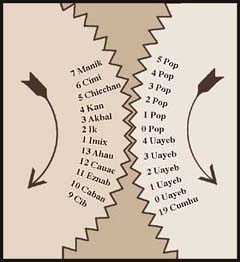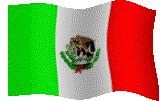The Maya Calendar we find in the codices that survived the Spanish conquest and the burning of documents by Bishop Diego de Landa, at Mani, Yucatán, México is used today to corroborate the calculations written in those codices and to calculate the dates of the Maya stelae and lintels. This calendar is called the initial series calendar or the long count calendar and it includes the following three individual calendars which are perfectly coordinated.
a).- An astronomical calendar which initiates on the date the Sun passes perpendicularly through the zenith, a day between the 24 - 26 of July each year. Its calculated to be 365.2420 days long and was used to fix the position of the solstices, the equinoxes, the synodic revolutions of the planets in our solar system, the eclipse nodes and other celestial phenomena. This calendar must have been the base of reference used by the Maya astronomer - priests for their astronomical calculations which were made with a minimum of 4 decimals. Examples of this can be found in the codices.
b).- The civil calendar or Haab of 365 days is often referred to as the Vague Year. It is composed of 18 months of 20 days and one month 5 days long called uayeb. The difference of one fourth of a day in regard to the astronomical calendar makes a periodical correction necessary through methods foreseen by the Maya. Within this calendar runs the Tun year 360 days long which was used for calendric calculations.
c).-The Tzolkin, Mayan name that means "the distribution of the days", was a ceremony performed on the astronomical new year. In this ceremony the astronomer - priests indicated the days in which the agricultural labor and religious ceremonies were to take place within a 260 day cycle. The Tzolkin is also the name used to designate the most important calendar of the Maya which has also been called the sacred almanac or the Sacred Round. It is a combination of a cycle of 13 day numbers with a cycle of 20 day names (the Kin). In every 365 day Haab year there always runs a 260 day Tzolkin calendar.
The Maya usually described a date by specifying its position in both the Tzolkin and the Haab calendars, this alignment of the Sacred Round and the Vague Year generates the joint cycle called the Calendar Round.

In these two wheels, the smallest with 260 teeth (left) has on each
one the name of the 260 days of the Tzolkin year and the largest
with 365 teeth (right) has in their interstice the names of each of the
positions of the Haab year. Since the Haab year always begins
on a date 0 Pop and the Tzolkin year can only began in a
day called Ik, Manik, Eb or Caban, when 2 Ik is placed
in conjunction with 0 Pop and wheel A is rotated clockwise wheel
B will rotate counterclockwise and the name of the Tzolkin day
that corresponds to each Haab position falls into place.
